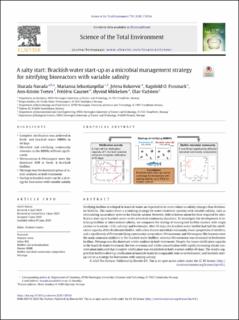| dc.contributor.author | Navada, Sharada | |
| dc.contributor.author | Sebastianpillai, Marianna | |
| dc.contributor.author | Kolarevic, Jelena | |
| dc.contributor.author | Fossmark, Ragnhild Olsen | |
| dc.contributor.author | Tveten, Ann-Kristin | |
| dc.contributor.author | Gaumet, Frederic | |
| dc.contributor.author | Mikkelsen, Øyvind | |
| dc.contributor.author | Vadstein, Olav | |
| dc.date.accessioned | 2020-06-11T07:20:33Z | |
| dc.date.available | 2020-06-11T07:20:33Z | |
| dc.date.created | 2020-06-10T12:07:04Z | |
| dc.date.issued | 2020 | |
| dc.identifier.citation | Science of the Total Environment. 2020, 739 | en_US |
| dc.identifier.issn | 0048-9697 | |
| dc.identifier.uri | https://hdl.handle.net/11250/2657631 | |
| dc.description.abstract | Nitrifying biofilms developed in brackish water are reported to be more robust to salinity changes than freshwater biofilms. This makes them a promising strategy for water treatment systems with variable salinity, such as recirculating aquaculture systems for Atlantic salmon. However, little is known about the time required for nitrification start-up in brackish water or the microbial community dynamics. To investigate the development of nitrifying biofilms at intermediate salinity, we compared the startup of moving bed biofilm reactors with virgin carriers in brackish- (12‰ salinity) and freshwater. After 60 days, the brackish water biofilm had half the nitrification capacity of the freshwater biofilm, with a less diverse microbial community, lower proportion of nitrifiers, and a significantly different nitrifying community composition. Nitrosomonas and Nitrosospira-like bacteria were the main ammonia oxidizers in the brackish water biofilms, whereas Nitrosomonas was dominant in freshwater biofilms. Nitrotoga was the dominant nitrite oxidizer in both treatments. Despite the lower nitrification capacity in the brackish water treatment, the low ammonia and nitrite concentration with rapidly increasing nitrate concentration indicated that complete nitrification was established in both reactors within 60 days. The results suggest that biofilms develop nitrification in brackish water in comparable time as in freshwater, and brackish start-up can be a strategy for bioreactors with varying salinity. | en_US |
| dc.language.iso | eng | en_US |
| dc.publisher | Elsevier | en_US |
| dc.rights | Navngivelse 4.0 Internasjonal | * |
| dc.rights.uri | http://creativecommons.org/licenses/by/4.0/deed.no | * |
| dc.title | A salty start: Brackish water start-up as a microbial management strategy for nitrifying bioreactors with variable salinity | en_US |
| dc.type | Peer reviewed | en_US |
| dc.type | Journal article | en_US |
| dc.description.version | publishedVersion | en_US |
| dc.source.volume | 739 | en_US |
| dc.source.journal | Science of the Total Environment | en_US |
| dc.identifier.doi | https://doi.org/10.1016/j.scitotenv.2020.139934 | |
| dc.identifier.cristin | 1814770 | |
| dc.description.localcode | This is an open access article distributed under the terms of the Creative Commons CC-BY license, which permits unrestricted use, distribution, and reproduction in any medium, provided the original work is properly cited. | en_US |
| cristin.ispublished | true | |
| cristin.fulltext | original | |
| cristin.qualitycode | 2 | |

